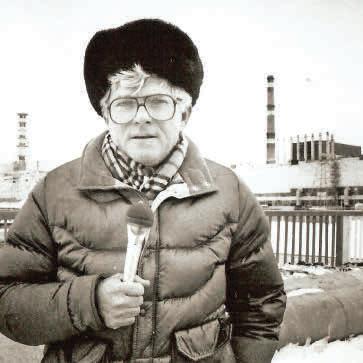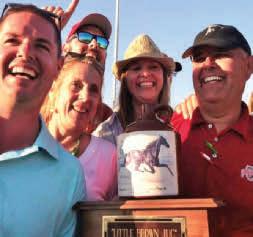
4 minute read
Pioneer of Daytime TV Talk
BEFORE THERE WAS OPRAH, THE VIEW OR ELLEN, THERE WAS PHIL DONAHUE
A former news anchor and talk radio host, Phil Donahue pioneered the modern daytime TV talk show in 1967 on WLWD in Dayton. The Phil Donahue Show, later simply Donahue, was unlike any other talk show. There was no couch, opening monologue, band or sidekick, and Donahue interviewed experts on everything from abortion, drug abuse, suicide, impotence and incest to alcoholism, feminism, racism, consumerism, pacifism, Nazism and nudism.
Journalist, Author, Catalyst, Lecturer, Traveler
THE MANY TALENTS OF KAY HALLE
Kay Halle (1903-1997) was a child of privilege. Her father and uncle had founded The Halle Brothers Co., one of Cleveland’s premier department stores. Turning down a 1931 marriage proposal by Randolph Churchill, son of Sir Winston, she chose to keep her freedom, becoming a journalist, author, lecturer and traveler, serving as an OSS intelligence operative in World War II and hosting a parade of 20th-century luminaries in her New York and D.C. homes.
Ladies’ Night, Every Night SUMMIT STATION
In 1970, trumpeter, pianist and classically trained musician Petie Brown got a bartending job at Jack’s A-Go-Go, an unassuming neighborhood bar near Ohio State’s Columbus campus. Word spread fast that a lesbian was behind the bar. Soon Jack’s began attracting lesbian women customers in scores. Renamed Summit Station, it became a safe space for many, and Ohio’s longest-running lesbian bar. Closed in 2008, it’s soon to be the subject of a new brown-and-gold Ohio Historical Marker.


A Dollar and a Dream
The Birth Of The Ohio Lottery
In 1971, Ohio Senator Ron Mottl Sr. was an up-and-coming Democratic lawmaker from Parma intent on making sure the state didn’t miss out on what he thought was a golden opportunity. Lottery fever was sweeping the country, and states all around Ohio were catching it. “I wanted to keep Ohio’s money in Ohio,” Mottl says. In 1973, voters made their wishes known, and in May 2023, the Ohio Lottery turns 50.
From Our Editors
We recently moved from our pre-pandemic office into new digs at the Ohio History Center. Though moving isn’t our idea of fun, we’re glass-half-full kinda people, and this move had a definite bright side: Mainly, the opportunity to put our hands on all of the books in the Echoes Magazine library and find out just what we have on our shelves. Books are like friends: If you never see them, do they really exist? In 2017, we received one that got shelved haphazardly and hence had been unseen for six years. That’s way too long to go without seeing a good friend. (See page 50.)
An Odd Book: How the First Modern Pop Culture Reporter Conquered New York, by R. Scott Williams, is a wonderful biography of O.O. “Odd” McIntyre of Gallipolis, a small-town kid who made it in the big city as a journalist and friend to celebrities, becoming one of the highest-paid reporters of the 1920s and 1930s.
McIntyre may have lived much of his adult life in New York’s Ritz-Carlton Hotel, but to paraphrase his contemporary, James Thurber, the clocks that rang in his dreams were, no doubt, the clocks of Gallipolis.
Now that we’re back in touch, let’s let Odd tell us in his own words:
“I know that as I sat in the very heartbeat of the greatest city in the world, the years rolled suddenly back and I was a boy … I heard again the melancholy drone of the honeybees and that dolorous ring of the blacksmith’s anvil back of McCormack’s livery stable. I heard old Mr. Kraus from his seat on the huckster wagon intone, ‘Ask your ma does she want any strawberries, bub.’
“I heard the clatter of the Ohio River Railroad hack moving toward the depot to meet what we knew as ‘the noon train.’ I heard the flying hoofs of Aaron Frank’s black stallion, ‘Flaming Arrow,’ beat against the walls of his stable stall … I saw the cobblestone gutters painted with fresh spring rain, I saw wisps of smoke haze from scattered chimney tops. I saw the West Virginia hills over yonder cowling in dusk and a faint prick of stars in the plush night.”
We feature a couple of remarkable Ohioans in this issue, namely talk show pioneer Phil Donahue (page 24) and journalist Kay Halle (page 30). We wonder what TV would look like today had Donahue not led the way. Oprah has always said that it was Donahue who made her show (and career) possible. We had a lot of fun reading through Halle’s FBI file. (It’s declassified—you can find it online.) Nothing scandalous, though she rubbed shoulders with so many VIPs that she raised J. Edgar Hoover’s eyebrows.
In June, the Ohio History Connection unveils its third brown-and-gold Ohio Historical Marker recognizing LGBTQ+ history in our state, on the site of Summit Station, a neighborhood landmark associated with lesbian history in Columbus from 1970 to 2008. Learn more on page 36.
Fifty years ago, Ohioans voted for a statewide lottery. (See page 40.) Though many opposed a lottery, the General Assembly recognized that Ohioans were traveling across state lines to bet on the numbers, spending money it figured should stay in Ohio.
Finally, thanks to Shem Schutte, who took the photos of Springfield's Hattie Moseley mural that appeared on the cover and pages 24–25 of our March & April 2023 issue, which were miscredited.
What ’s
In every issue of Echoes Magazine, we feature the stories of Ohio History Connection members and other Ohioans to stoke memories and shed light on our shared past.
For this issue, we asked, What are your memories of attending horse races in Ohio, Thoroughbred or Standardbred?”
Here are some of your responses:
Backstretch Dreams
The Wingfield family is passionate about horse racing. Oldest brother Charlie started attending the Delaware County Fair, host to the Little Brown Jug, after high school graduation in 1964, and hasn’t missed a year since. He never dreamed that 50 years later, he’d be running from the backstretch to be in the 2014 winner’s circle with Limelight Beach. In summer 2014, Limelight Beach wasn’t looking like a winner to anyone. He hadn’t won one race, though the four Wingfield brothers hung on to their dream. Our group of lawn chairs on the backstretch was full of excited family members and friends on Sept. 18 as the long day of racing began. With 40,000 fans crowded around the oval, Limelight










